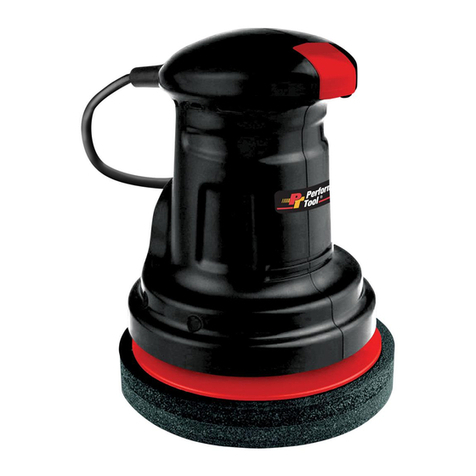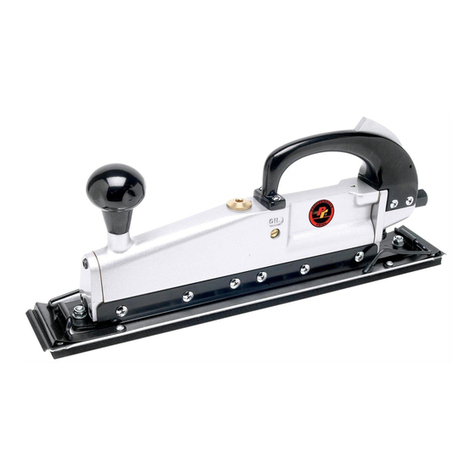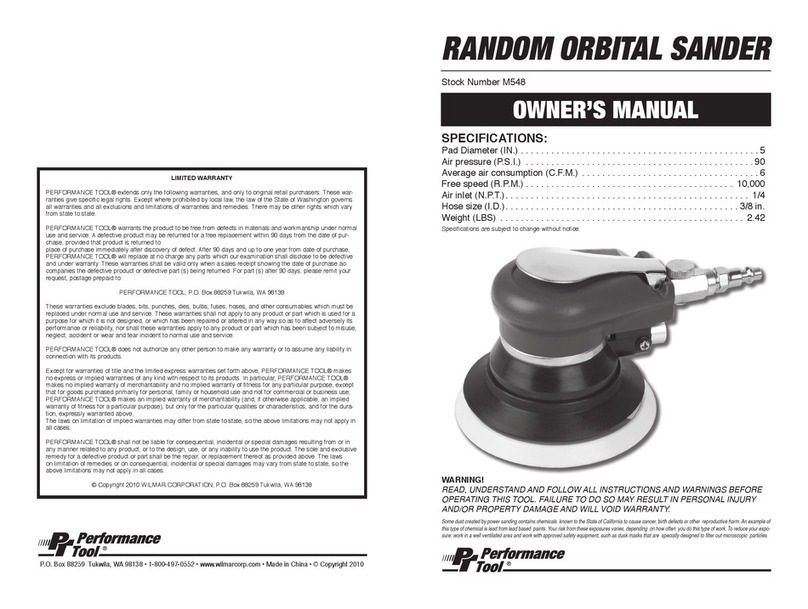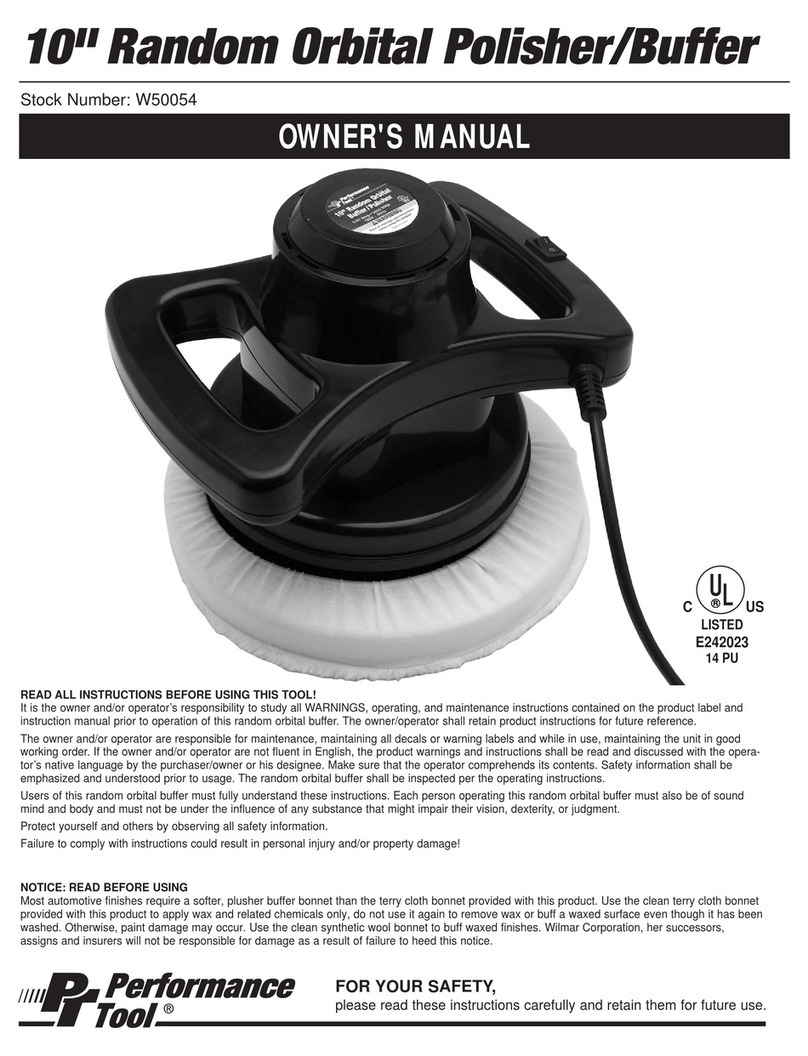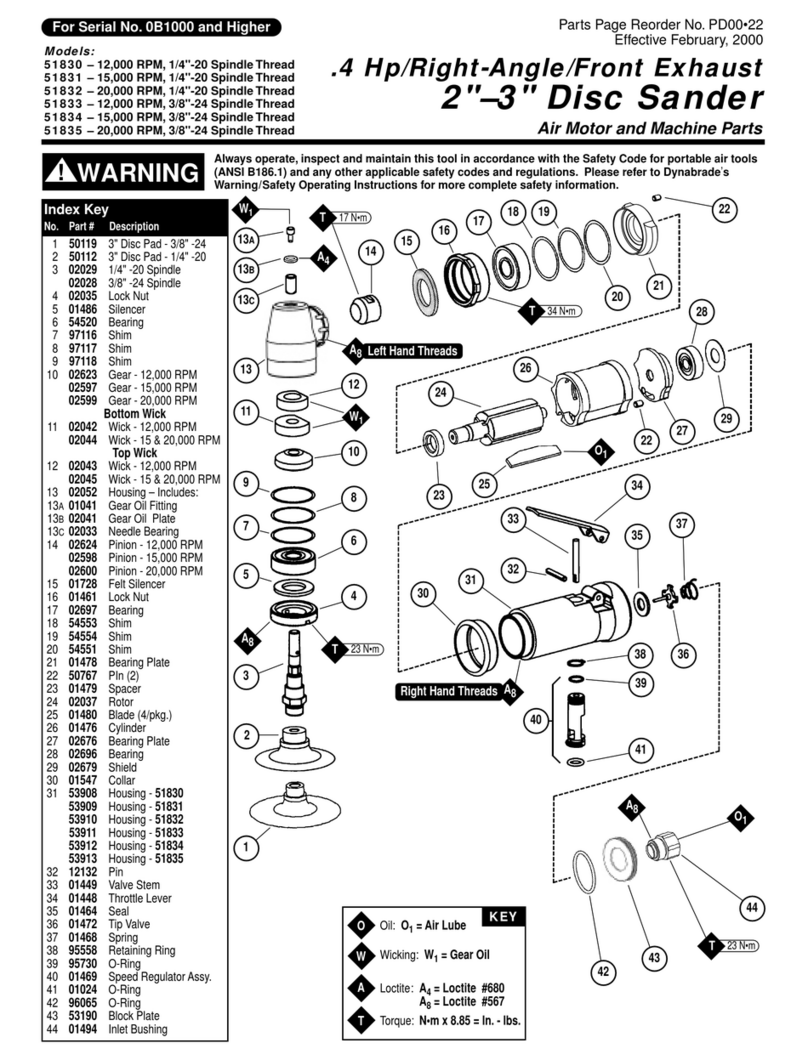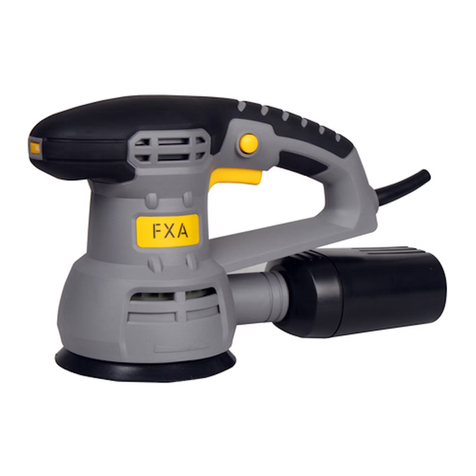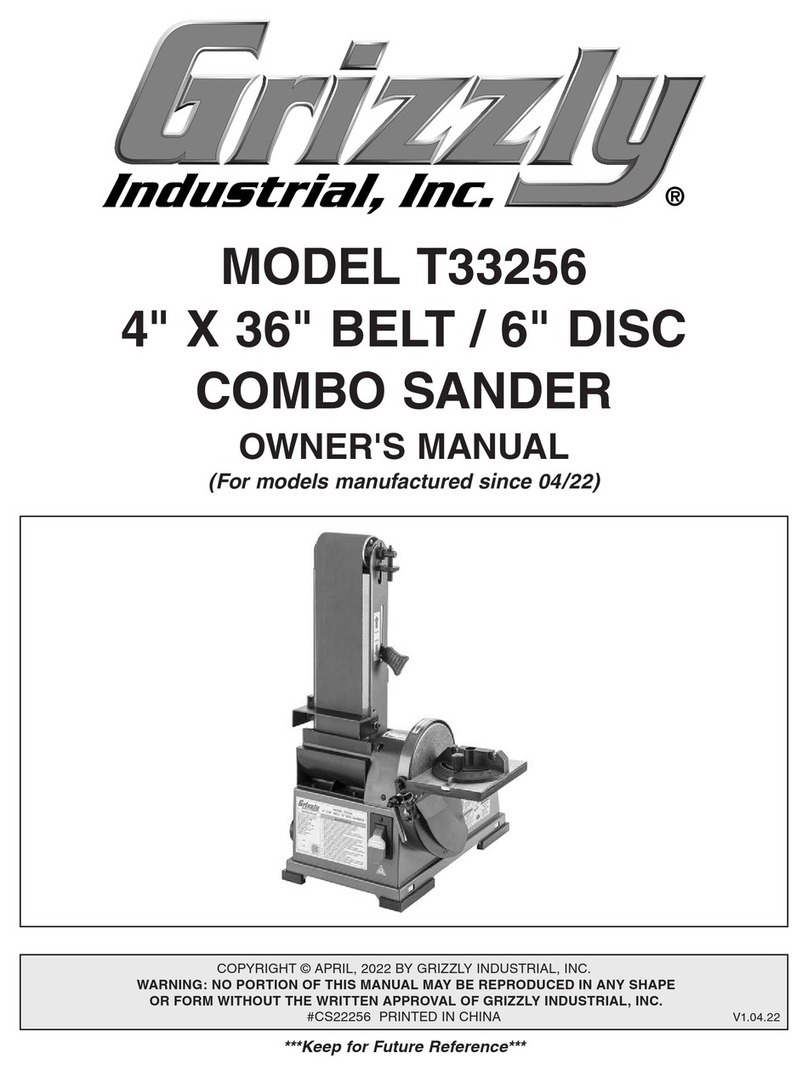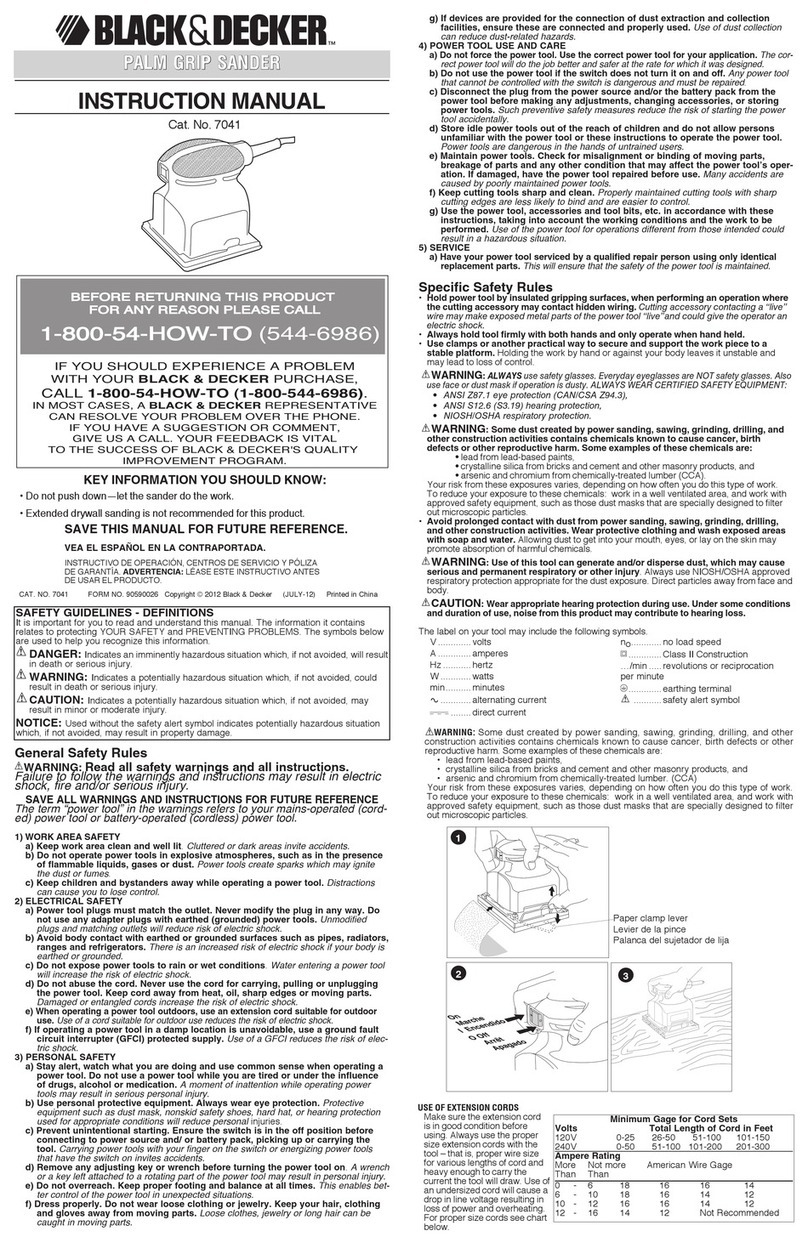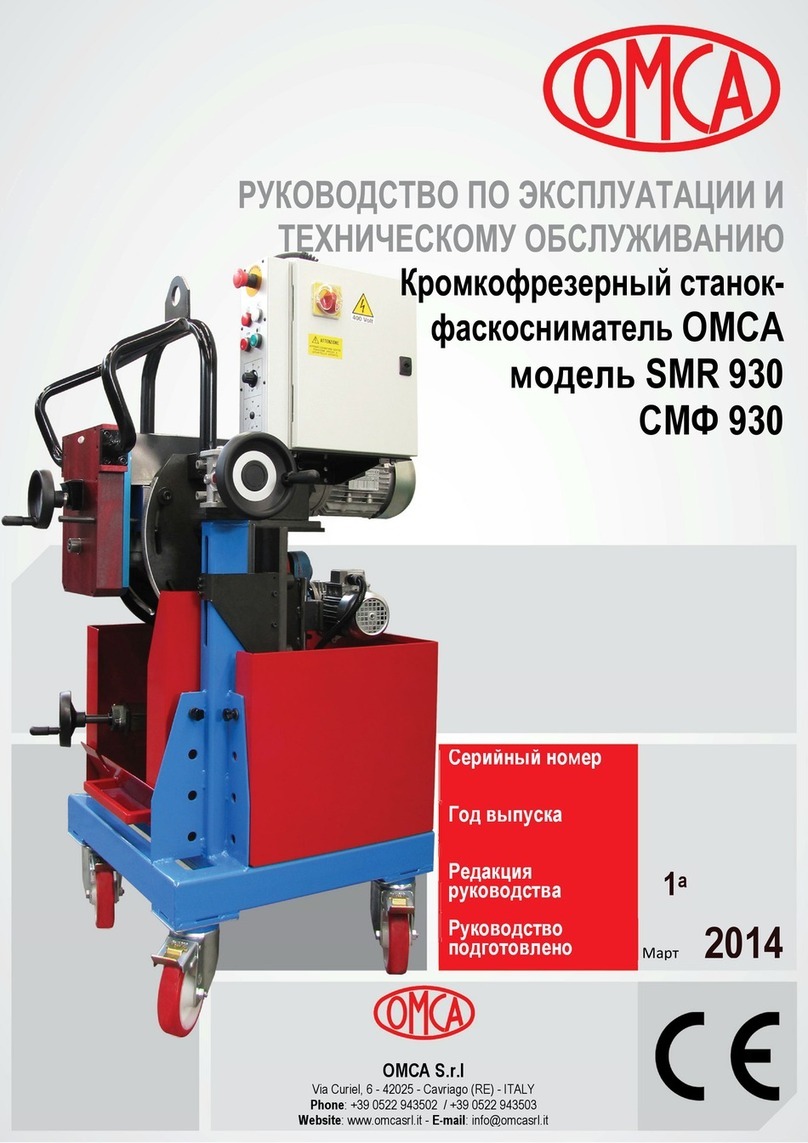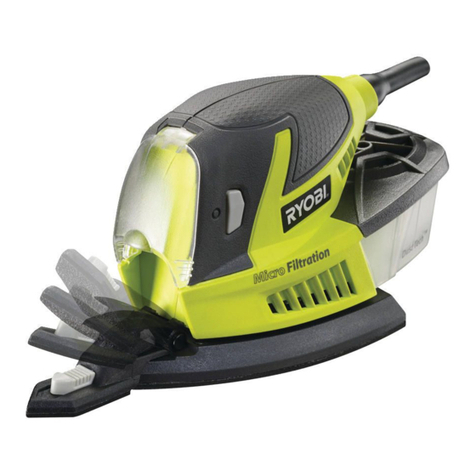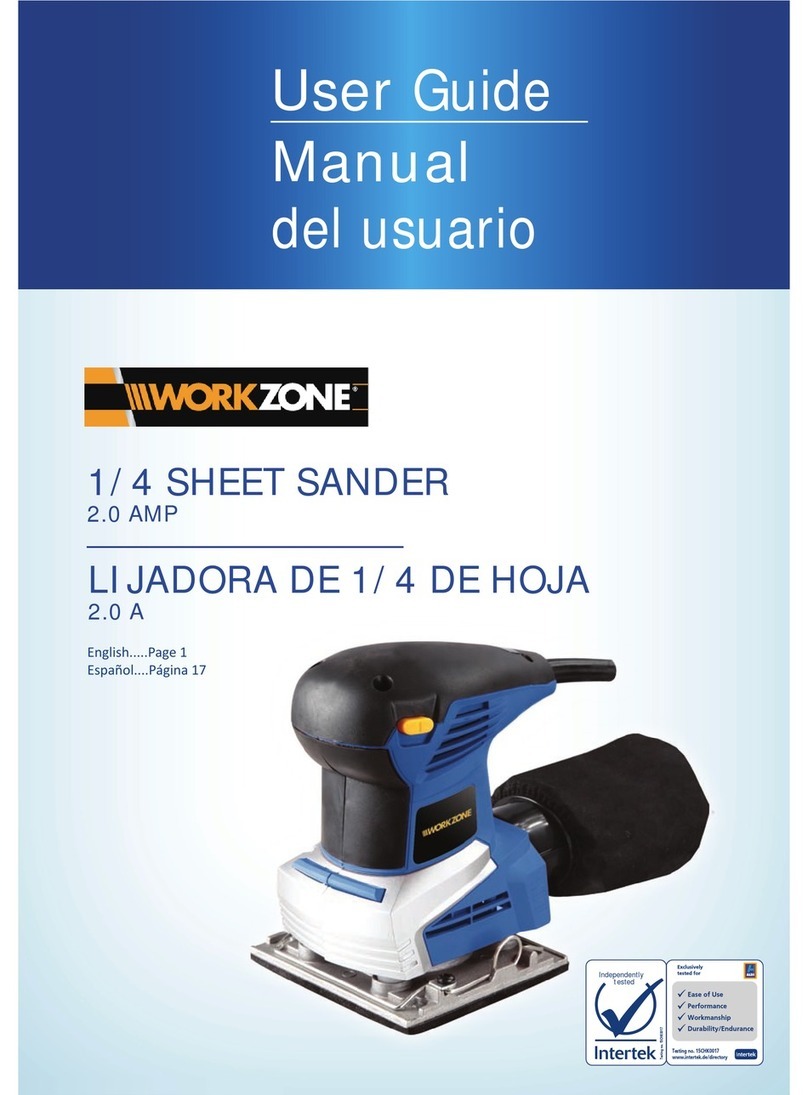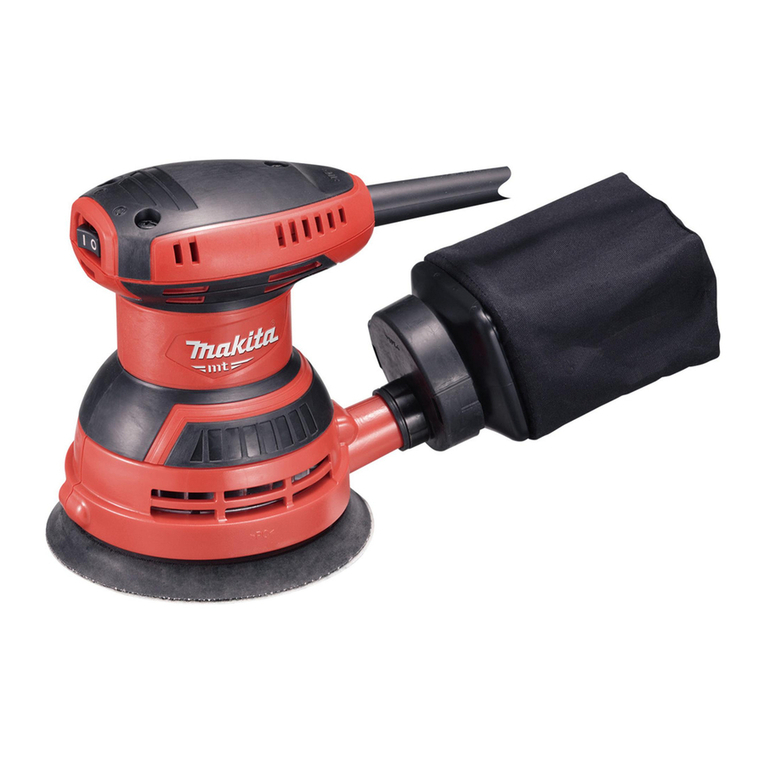49
IMPORTANT SAFETY INFORMATION
34. Do not use a damaged accessory. Before each use inspect
the accessory such as abrasive wheels for chips and cracks,
backing pad for cracks, tear or excess wear, wire brush for
loose or cracked wires. If power tool or accessory is dropped,
inspect for damage or install an undamaged accessory.After
inspecting and installing an accessory, position yourself and
bystanders away from the plane of the rotating accessory and
run the power tool at maximum no-load speed for one minute.
Damaged accessories will normally break apart during this
test time.
35. Hold power tool by insulated gripping surfaces only, when
performing an operation where the accessory may contact
hidden wiring or its own cord. An accessory contacting a “liveˮ
wire may make exposed metal parts of the power tool “live”
and shock the operator.
36. Do not use accessories that require liquid coolants. Using
water or other liquid coolants may result in electrocution or
shock.
37. Do not depress the spindle lock when starting or during
operation.
38. Use clamps (not included) or other practical ways to secure
and support the workpiece to a stable platform. Holding the
work by hand or against your body is unstable and may lead
to loss of control and personal injury.
39. WARNING: Some dust created by power sanding, sawing,
grinding, drilling, and other construction activities, contains
chemicals known [to the State of California] to cause cancer,
birth defects or other reproductive harm. Some examples of
these chemicals are:
• Lead from lead-based paints.
• Crystalline silica from bricks and cement or other masonry
products.
• Arsenic and chromium from chemically treated lumber.
Your risk from these exposures varies, depending on how
often you do this type of work. To reduce your exposure to
these chemicals: work in a well ventilated area, and work
with approved safety equipment, such as those dust masks
that are specially designed to lter out microscopic particles.
(California Health & Safety Code § 25249.5, et seq.)
40. WARNING: Handling the cord on this product will expose you
to lead, a chemical known to the State of California to cause
cancer, and birth defects or other reproductive harm. Wash
hands after handling. (California Health & Safety Code §
25249.5, et seq.)
41. KICKBACK WARNING: Kickback is a sudden reaction to a
pinched or snagged rotating wheel, backing pad, brush or any
other accessory. Pinching or snagging causes rapid stalling of
the rotating accessory which in turn causes the uncontrolled
power tool to be forced in the direction opposite of the acces-
sory’s rotation at the point of the binding. For example, if an
abrasive wheel is snagged or pinched by the workpiece, the
edge of the wheel that is entering into the pinch point can dig
into the surface of the material causing the wheel to climb out
or kick out. The wheel may either jump toward or away from
the operator, depending on direction of the wheel’s movement
at the point of pinching. Abrasive wheels may also break
under these conditions. Kickback is the result of power tool
misuse and/or incorrect operating procedures or conditions
and can be avoided by taking proper precautions as given
below.
1. Maintain a rm grip on the power tool and position your
body and arm to allow you to resist kickback forces. always
use auxiliary handle, if provided, for maximum control over
kickback or torque reaction during start-up. The operator can
control torque reactions or kickback forces, if proper precau-
tions are taken.
2. Never place your hand near the rotating accessory.Acces-
sory may kickback over your hand.
3. Do not position your body in the area where power tool
will move if kickback occurs. Kickback will propel the tool in
direction opposite to the wheel’s movement at the point of
snagging.
4. Use special care when working corners, sharp edges etc.
avoid bouncing and snagging the accessory. Corners, sharp
edges or bouncing have a tendency to snag the rotating
accessory and cause loss of control or kickback.
5. Do not attach a saw chain woodcarving blade or toothed
saw blade. Such blades create frequent kickback and loss of
control.
42. VIBRATION WARNING: This tool vibrates during use.
Repeated or long-term exposure to vibration may cause tem-
porary or permanent physical injury, particularly to the hands,
arms and shoulders. To reduce the risk of vibration-related
injury:
1. Anyone using vibrating tools regularly or for an extended
period should rst be examined by a doctor and then have
regular medical check-ups to ensure medical problems are
not being caused or worsened from use. Pregnant women
or people who have impaired blood circulation to the hand,
past hand injuries, nervous system disorders, diabetes, or
Raynaud’s Disease should not use this tool. If you feel any
medical or physical symptoms related to vibration (such as
tingling, numbness, and white or blue ngers), seek medical
advice as soon as possible.
2. Do not smoke during use. Nicotine reduces the blood
supply to the hands and ngers, increasing the risk of
vibration-related injury.
3. Wear suitable gloves to reduce the vibration effects on the
user.
4. Use tools with the lowest vibration when there is a choice
between different processes.
5. Include vibration-free periods each day of work.
6. Grip tool as lightly as possible (while still keeping safe
control of it). Let the tool do the work.
7. To reduce vibration, maintain the tool as explained in
this manual. If any abnormal vibration occurs, stop use
immediately.
43. The warnings, precautions, and instructions discussed in
this instruction manual cannot cover all possible conditions
and situations that may occur. It must be understood by the
operator that common sense and caution are factors which
cannot be built into this product, but must be supplied by the
operator.
WARNING: Some dust created by power sanding, sawing, grind-
ing, drilling and other construction activities contains chemicals
known to the State of California to cause cancer, birth defects or
other reproductive harm.
WARNING: This product and its packaging contain a chemical
known to the State of California to cause cancer, birth defects, or
other reproductive harm.
OPERATION
3. Rotate the Speed Dial to select the
desired speed setting.
4. Plug the Power Cord of the Polisher/
Sander into a grounded 120 volt,
electrical outlet.
5. To start, grip the Polisher/Sander rmly
with both hands and press the Trigger.
Release the Trigger to stop. To use the
Lock on button, while holding in the
Trigger, press the Lock On Button, then
release the Trigger. The Polisher/Sander
will stay on. Press and release the
Trigger to stop.
6. Wait until the Polisher/Sander has
reached full speed, then gently contact
the surface.
7. Keep heavy pressure off of the Polisher/
Sander when operating. Allow the
sanding disk to do the work.
8. Move the Polisher/Sander in a uniform
pattern up and down or side to side as
you sand to ensure even sanding.
9. Periodically, stop the Polisher/Sander
and check for possible disc wear.
Replace used or worn sanding discs
when necessary.
10. When nished, turn off and unplug the
Polisher/Sander.
11. Allow the tool to come to a complete
stop before setting it down.
12. To prevent accidents, turn off the tool
and disconnect its power supply after
use. Clean, then store the tool indoors
out of children’s reach.
CARE & MAINTENANCE
NOTICE
Procedures not specifically ex-
plained in this manual must be performed
only by a qualified technician.
WARNING
TO PREVENT SERIOUS
INJURY FROM A ACCIDENTAL OPERA-
TION: Release the trigger and unplug
the tool from its electrical outlet before
performing any inspection, maintenance,
or cleaning procedures.
WARNING
TO PREVENT SERIOUS
INJURY FROM TOOL FAILURE: Do not
use damaged equipment. if abnormal
noise or vibration occurs, have the prob-
lem corrected before further use.
1. BEFORE EACH USE, inspect the
general condition of the tool. Check for:
• loose hardware,
• misalignment or binding of
moving parts,
• cracked or broken parts,
• damaged electrical wiring, and
• any other condition that may
affect its safe operation.
2. AFTER USE, wipe external surfaces of
the tool with clean cloth.
3. Periodically blow dust and grit out of the
motor vents using dry compressed air.
WearANSI-approved safety goggles and
NIOSH-approved breathing protection
while doing this.
4. Periodically recheck all nuts, bolts, and
screws for tightness.
5. Remove Foam Pad from Backing Pad
when Polisher/Sander is not in use. This
will allow Backing Pad to dry and retain
its original shape. Wash with mild soap
and water before storing.
6. The Polishing Bonnet may be machine
washed in cold water with mild
detergent. Do not put in the dryer.
7. Use only a clean cloth and mild
detergent to clean the body of the
Polisher. Do not use solvents. Do not
immerse any part of the tool in liquid.
8. CARBON BRUSH MAINTENANCE.
The carbon brushes may require
maintenance when the motor
performance of the tool decreases or
stops working completely. To maintain
the brushes:
a. Remove the Carbon Brush Cover on
each side of the motor housing.
b. Remove the carbon brushes from the
housing. Keep track of which
orientation the old carbon brushes
were in to prevent needless wear if


